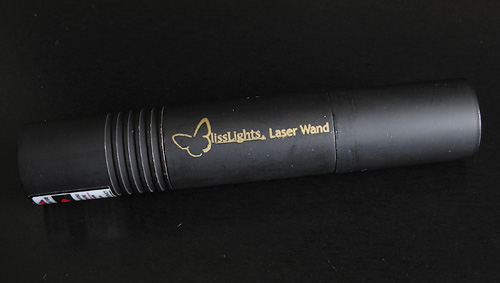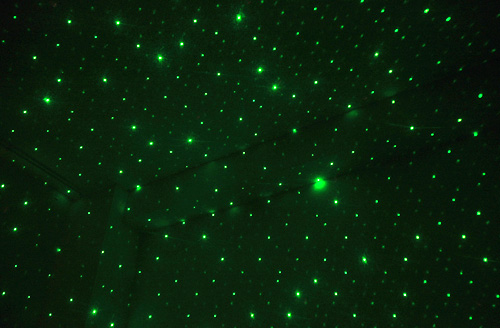
By Andrew Liszewski
As a blogger I end up reading about hundreds of different gadgets on a weekly basis. And unfortunately my experience with the majority of them is limited to what information is provided on a company’s website or in a press release. So when I write about a gadget that I haven’t actually had the chance to play with, I’m forced to rely on those ‘facts’ as well as my experiences with similar technology when it comes to determining if a given device has the potential to be worth my (and your) investment. Sometimes I’m impressed with their functionality or feature list, and other times I’m less than convinced about a product’s claims.
Such was the case with the BlissLights Laser Wand which I originally wrote about just over a month ago. While we here at OhGizmo! are big fans of lasers, I questioned the safety and overall usefulness of the Laser Wand, and in the end I wasn’t particularly impressed. However, shortly after writing that post I was contacted by BlissLights who felt that if I had the chance to actually play with the Laser Wand I might change my opinion. So because I can never say no to the opportunity of playing with a laser, I agreed to give them the benefit of the doubt and give it a try.
And I can honestly say that after playing with it for a few weeks, my opinion has changed. While it might not be the best choice if you’re specifically looking for a laser pointer, the BlissLights Laser Wand will make a unique addition to any laser fan’s collection, and you can read my full review of it after the jump.
BlissLights Laser Wand

The Laser Wand itself is pretty mundane, and isn’t going to win any design awards when it comes to the housing. It’s basically a metal tube with a black matte finish that also features the BlissLights company logo and the name of the laser, in gold, on the side. As you might be able to see in this photo, the black paint is actually starting to come off in a few areas so I wouldn’t recommend carrying the laser in a pocket with your keys since it will probably take the finish off even faster.
Overall there’s definitely nothing fancy about the Laser Wand that would make it stand out in a group of other handheld lasers, but that’s pretty much been the case for every laser I’ve had the chance to play with over the years. I guess in the end, what a laser is capable of is far more important than how it looks.

As for its size, the Laser Wand fits great in your hand and has a nice heft since it’s made from actual metal. Here’s a photo of it next to the Wicked Lasers Photonic Disruptor which takes a longer and thinner approach. But I have to say I prefer the shorter and thicker design of the Laser Wand which feels better in your hand and fits better in your pocket than the Photonic Disruptor.

Here’s another size comparison shot with the Laser Wand sitting next to a fine point Sharpie. As you can see, it’s easily twice as thick as your standard writing instrument.

Near the top of the laser you’ll find the only detailing on the metal housing which is a series of parallel ridges that are designed to provide a bit more grip while the laser’s in your hand. It’s nothing fancy, but I’ve also found that it makes it easier to tell which end the beam actually comes out of when you’re using it in a dark room. (Before you turn it on of course.)

And at the very tip of the laser you’ll find the all important safety warning. Like the Photonic Disruptor, the Laser Wand is a Class IIIb laser product and this was one of my concerns when I originally wrote about it. If anything, the Photonic Disruptor taught me that green lasers are not a toy and should be taken extremely seriously. But the BlissLights’ website promotes using the Laser Wand at parties or other crowded events, and even features images of it being projected onto kids who aren’t wearing any eye protection.
However, while the Photonic Disruptor has a power rating of 100mw, the Laser Wand is rated at less than 5mw. And when you consider that the beam is further split into at least a thousand smaller beams, it ends up being relatively safe. BUT! It’s still a green laser and it’s still extremely bright, particularly if someone were to look directly into where the beam was being emitted. So if it was safely mounted in a place where people (particularly children) couldn’t look directly into the beam, I do think the Laser Wand can be considered safe. But it should never be considered a toy, and proper caution should always be taken while it’s turned on. Safety first!

On the other end of the laser you’ll find the removable cap where the battery is inserted. Like the rest of the laser it’s made from machined metal, and is removed by simply unscrewing it.

One of the things I don’t like about the Laser Wand is that it uses CR2 batteries. I realize that it allows the laser to be smaller in size, but the batteries are far less common than AAs or AAAs. They’re still easy to find at most electronic stores, but odds are your local convenience store might not carry them. On the plus side though, with a single CR2 battery you can expect to get about 10 hours of operation with the Laser Wand which is actually pretty decent. In comparison, the Photonic Disruptor runs for maybe 10 minutes on 2 AAAs, though the difference in power rating plays a big part there.

For the review I bought a name brand backup CR2 battery and it actually cost me about $15, though south of the border and online it seems they’re closer to $10. So if you plan on using the Laser Wand as part of your DJ service or at various parties, you might want to buy in bulk.

The front of the laser is where all the ‘magic’ happens. As you can see here, the emitter is covered by a “high diffraction efficiency digital holographic optical element” as BlissLights refers to it. I’m not sure what it makes it digital per se, but it’s this thin element that splits the single laser beam into 1,000+ smaller beams. And this brings me to what I consider to be the other big downside of the Laser Wand. As you can see in the photo the optical element is basically glued over the laser emitter, which means you can’t turn off the starfield effect. The laser is basically in a permanent starfield mode.
Now I realize that adding a mechanical means for the optical element to flip out of the way would have added extra cost to the laser, but even having it as a screw on accessory would allow the laser to be used as a standard pointer as well. I’m sure there are other factors as to why the starfield effect can’t be temporarily switched off that I’m not aware of, but I just think that feature would add a lot to its overall usefulness.

On the other hand, here’s one aspect of the Laser Wand’s design that I really like. The on/off button is located in a recess on the bottom of the laser, and it’s not an intermittent button either. What I mean by that is most lasers are only ‘on’ for as long as you hold down the power button. Since the laser wand is designed to be left running for hours at a time, having an intermittent power switch would have just been stupid. And because the on/off button sits in a recessed area there’s less of a chance of it accidentally being turned on, even while it’s standing on a flat surface.

It might seem like an exaggeration, but even if you’ve had the chance to play with the most powerful lasers on Earth, I still think you’d be impressed when you first powered on the Laser Wand. Because it’s a green laser the starfield effect it produces is extremely vivid, and even though it has a power rating of just 5mW, the dots it produces are very bright even with the lights on. But as you can see in this image, the size and brightness of the dots that make up the starfield varies. So while you can use it day or night, you’ll actually be able to see quite a few more ‘stars’ when it’s dark. And while I haven’t sat down and counted them, the stars easily number in the thousands. (I’ll get around to counting them some day.)
A good comparison of the Laser Wand’s starfield effect would be to think of the effect produced by a disco ball. Except that the dots produced by the Laser Wand are far more distinct, and they’re green. So it makes sense why BlissLights promotes the laser for use at parties or other events, since it can basically serve as a pocket-friendly disco ball. The only thing you’d need is some mechanism to make it slowly spin.

And speaking of spinning, the starfield effect also makes for some great long exposure shots. If you’ve ever messed around with a standard laser pointer and a camera, imagine what you could do with a thousand at once. (A thousand lasers that is, not a thousand cameras.)

Finally, I’ve also found that the LaserWand’s starfield effect works just as well whether you’re pointing it at your keyboard from a foot away, or using it in a large open space. When positioned properly you can easily get the starfield to fill any location, but like I’ve already mentioned, you’ll want to keep safety in mind if you’re expecting a large crowd.
Conclusions:
One issue I brought up in my review of the Wicked Lasers Photonic Disruptor is that most people have no need for a laser, let alone a particularly bright and still relatively expensive green one. Sure, you can justify the purchase if you happen to need to point at a PowerPoint presentation from a mile away, but other than that, this is definitely not the type of gadget where ‘need’ plays a big role. Particularly when it comes to something like the Laser Wand which can only be used to produce a starfield effect.
So if you’re looking for a basic laser pointer, I’d suggest looking elsewhere. But if you’re looking for a laser that will impress your friends and maybe add a bit of atmosphere to your next party, the BlissLights Laser Wand would make a great addition to your collection.
Pros:
+ Extremely vivid and unique starfield effect.
+ Can be simply switched on and left running. No need to continuously hold the power button.
+ Does not overheat if left running for long periods.
+ Relatively inexpensive ($99.95) given how much some high-powered green lasers cost.
+ Relatively safe if you take the right precautions.
Cons:
– Green lasers are still considerably more expensive than red lasers.
– Starfield effect can’t be switched off or disabled.
– It’s still a green laser that can cause eye damage if you don’t take the proper precautions.
– Replacement CR2 batteries can be expensive and harder to find.
Links:
BlissLights Handheld Laser Wand – $99.95
If you have any questions about the BlissLights Laser Wand you’d like answered, please feel free to leave them in the comments, and I’ll try to respond to them as best I can.










